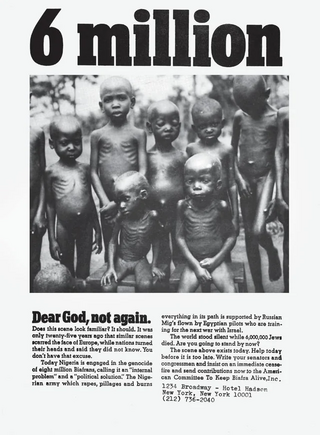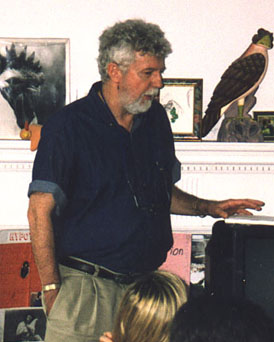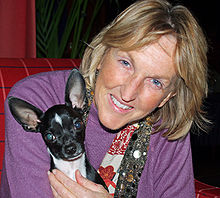
Nazi Germany used six extermination camps, also called death camps, or killing centers, in Central Europe during World War II to systematically murder over 2.7 million people – mostly Jews – in the Holocaust. The victims of death camps were primarily murdered by gassing, either in permanent installations constructed for this specific purpose, or by means of gas vans. The six extermination camps were Chełmno, Belzec, Sobibor, Treblinka, Majdanek and Auschwitz-Birkenau. Extermination through labour was also used at the Auschwitz and Majdanek death camps. Millions were also murdered in concentration camps, in the Aktion T4, or directly on site.

Treblinka was the second-deadliest extermination camp to be built and operated by Nazi Germany in occupied Poland during World War II. It was in a forest north-east of Warsaw, 4 km (2.5 mi) south of the village of Treblinka in what is now the Masovian Voivodeship. The camp operated between 23 July 1942 and 19 October 1943 as part of Operation Reinhard, the deadliest phase of the Final Solution. During this time, it is estimated that between 700,000 and 900,000 Jews were murdered in its gas chambers, along with 2,000 Romani people. More Jews were murdered at Treblinka than at any other Nazi extermination camp apart from Auschwitz-Birkenau.

People for the Ethical Treatment of Animals is an American animal rights nonprofit organization based in Norfolk, Virginia, and led by Ingrid Newkirk, its international president. PETA says that its entities have more than 9 million members globally.

Nazi concentration camp badges, primarily triangles, were part of the system of identification in German camps. They were used in the concentration camps in the German-occupied countries to identify the reason the prisoners had been placed there. The triangles were made of fabric and were sewn on jackets and trousers of the prisoners. These mandatory badges of shame had specific meanings indicated by their colour and shape. Such emblems helped guards assign tasks to the detainees. For example, a guard at a glance could see if someone was a convicted criminal and thus likely of a tough temperament suitable for kapo duty.

The Holocaust—the murder of about six million Jews by Nazi Germany from 1941 to 1945—is the most-documented genocide in history. Although there is no single document which lists the names of all Jewish victims of Nazi persecution, there is conclusive evidence that about six million Jews were murdered. There is also conclusive evidence that Jews were gassed at Auschwitz-Birkenau, the Operation Reinhard extermination camps, and in gas vans, and that there was a systematic plan by the Nazi leadership to murder them.
A Holocaust memorial day or Holocaust remembrance day is an annual observance to commemorate the victims of the Holocaust, the genocide of six million Jews and of millions of other Holocaust victims by Nazi Germany and its collaborators. Many countries, primarily in Europe, have designated national dates of commemoration. In 2005, the United Nations instituted an international observance, International Holocaust Remembrance Day.

Roberta Kalechofsky was an American writer, feminist and animal rights activist, focusing on the issue of animal rights within Judaism and the promotion of vegetarianism within the Jewish community. She was the founder of Jews for Animal Rights and Micah Publications or Micah Books, which specializes in the publication of animal rights, Jewish vegetarianism, and Holocaust literature.

Nazi analogies or Nazi comparisons are any comparisons or parallels which are related to Nazism or Nazi Germany, which often reference Adolf Hitler, Joseph Goebbels, the SS, or the Holocaust. Despite criticism, such comparisons have been employed for a wide variety of reasons since Hitler's rise to power. Some Nazi comparisons are logical fallacies, such as reductio ad Hitlerum. Godwin's law asserts that a Nazi analogy is increasingly likely the longer an internet discussion continues; Mike Godwin also stated that not all Nazi comparisons are invalid.

The International Holocaust Remembrance Day, or the International Day in Memory of the Victims of the Holocaust, is an international memorial day on 27 January that commemorates the victims of the Holocaust, which resulted in the genocide of one third of the Jewish people, along with countless members of other minorities by Nazi Germany between 1933 and 1945, an attempt to implement its "final solution" to the Jewish question. 27 January was chosen to commemorate the date when the Auschwitz concentration camp was liberated by the Red Army in 1945.
Holocaust victims were people targeted by the government of Nazi Germany based on their ethnicity, religion, political beliefs, disability or sexual orientation. The institutionalized practice by the Nazis of singling out and persecuting people resulted in the Holocaust, which began with legalized social discrimination against specific groups, involuntary hospitalization, euthanasia, and forced sterilization of persons considered physically or mentally unfit for society. The vast majority of the Nazi regime's victims were Jews, Sinti-Roma peoples, and Slavs but victims also encompassed people identified as social outsiders in the Nazi worldview, such as homosexuals, and political enemies. Nazi persecution escalated during World War II and included: non-judicial incarceration, confiscation of property, forced labor, sexual slavery, death through overwork, human experimentation, undernourishment, and execution through a variety of methods. For specified groups like the Jews, genocide was the Nazis' primary goal.
The Holocaust on your Plate was an exhibition mounted by People for the Ethical Treatment of Animals (PETA) in 2003. It was funded by an anonymous Jewish philanthropist, and consisted of eight 60-square-foot panels, each with a juxtaposition of images of the Holocaust with images of factory farming. Photographs of concentration camp inmates in wooden bunks were shown next to photographs of battery chickens, and piled bodies of Holocaust victims next to a pile of pig carcasses. Captions alleged that "like the Jews murdered in concentration camps, animals are terrorized when they are housed in huge filthy warehouses and rounded up for shipment to slaughter. The leather sofa and handbag are the moral equivalent of the lampshades made from the skins of people killed in the death camps."

Hedy Epstein was a German-born Jewish-American political activist and Holocaust survivor known for her support of the Palestinian cause through the International Solidarity Movement.

Holocaust trains were railway transports run by the Deutsche Reichsbahn and other European railways under the control of Nazi Germany and its allies, for the purpose of forcible deportation of the Jews, as well as other victims of the Holocaust, to the Nazi concentration, forced labour, and extermination camps.
Holocaust trivialization refers to any comparison or analogy that diminishes the scale and severity of the atrocities that were carried out by Nazi Germany during the Holocaust. The Wiesel Commission defined trivialization as the abusive use of comparisons with the aim of minimizing the Holocaust and banalizing its atrocities. Originally, holocaust meant a type of sacrifice that is completely burnt to ashes; starting from the late 19th century, it started to denote extensive destruction of a group, usually people or animals. The 1915 Armenian genocide was described as a "holocaust" by contemporary observers.

Norm Phelps was an American animal rights activist, vegetarian and writer. He was a founding member of the Society of Ethical and Religious Vegetarians (SERV), and a former outreach director of the Fund for Animals. He authored four books on animal rights: The Dominion of Love: Animal Rights According to the Bible (2002), The Great Compassion: Buddhism and Animal Rights (2004), The Longest Struggle: Animal Advocacy from Pythagoras to PETA (2007), and Changing the Game: Animal Liberation in the Twenty-first Century (2015).

Alex Hershaft is an American animal rights activist, Holocaust survivor, and co-founder and president of the Farm Animal Rights Movement (FARM), the nation's oldest (1976) organization devoted exclusively to promoting the rights of animals not to be raised for food. Previously, he has had a 30-year career in materials science and environmental consulting and a prominent role in movements for religious freedom and environmental quality.
Charles W. Patterson is an American author, historian, and animal rights advocate, best known for his books, Eternal Treblinka: Our Treatment of Animals and the Holocaust, Anti-Semitism: The Road to the Holocaust and Beyond, Animal Rights,The Civil Rights Movement, and Marian Anderson.

Rudolf (Rudi) Masarek was a Czech prisoner of the Treblinka extermination camp and a prominent member of the Treblinka prisoner uprising. Deported from the Theresienstadt concentration camp to Treblinka on 8 October 1942, Masarek was killed during that camp's prisoner uprising on 2 August 1943.

Comparisons between Israel and Nazi Germany occur frequently in some veins of anti-Zionism in relation to the Israeli–Palestinian conflict. The legitimacy of these comparisons and their potential antisemitic nature is a matter of debate. Historically, figures like historian Arnold J. Toynbee have drawn parallels between Zionism and Nazism, a stance he maintained despite criticism. Scholar David Feldman suggests these comparisons are often rhetorical tools without specific antisemitic intent. The Anti-Defamation League (ADL) sees them as diminishing the Holocaust's significance.
Eternal Treblinka: Our Treatment of Animals and the Holocaust is a non-fiction book by the American author Charles Patterson, first published in December 2001.
![Isaac Bashevis Singer's quote, "In relation to [animals], all people are Nazis; for the animals, it is an eternal Treblinka", became a classic reference in the discussions about the legitimacy of the comparison of animal exploitation with the Holocaust. Bilgoraj - Lawka Izaaka Baszewisa Singera (01) - DSC00455 v1.jpg](http://upload.wikimedia.org/wikipedia/commons/thumb/2/24/Bi%C5%82goraj_-_%C5%81awka_Izaaka_Baszewisa_Singera_%2801%29_-_DSC00455_v1.jpg/220px-Bi%C5%82goraj_-_%C5%81awka_Izaaka_Baszewisa_Singera_%2801%29_-_DSC00455_v1.jpg)
















